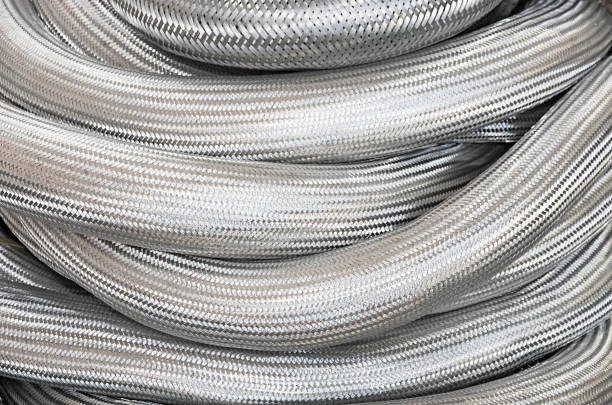
Reinforced braid hoses play a critical role in distribution networks, ensuring the safe and efficient transport of fluids and gases across numerous industries. Their ability to handle high pressure, resist abrasion, and maintain flexibility makes them indispensable in applications ranging from fuel and chemical transfer to water supply and hydraulic systems. This article offers a comprehensive overview of reinforced braid hoses, focusing on their importance in distribution, their defining features, common applications, and best practices for selection and use.
Frequently Asked Questions (FAQ)
- What are reinforced braid hoses, and why are they used in distribution?
Reinforced braid hoses are flexible tubes designed with a braided layer, often made of steel or synthetic materials, to enhance strength and pressure resistance. They are widely used in distribution systems because they can safely transport liquids and gases under high pressure, resist wear and tear, and adapt to complex routing requirements. - How do I choose the right reinforced braid hose for my distribution needs?
Selecting the right hose depends on factors like the type of medium being transported (e.g., water, chemicals, or fuels), operating pressure and temperature, environmental conditions, and compliance requirements. Always consult technical specifications and industry standards to ensure the hose meets your needs. - Can reinforced braid hoses be used for food and beverage distribution?
Yes, certain reinforced braid hoses are designed with food-grade materials, such as FDA-approved inner tubes and stainless steel braiding. These hoses are suitable for distributing beverages, dairy products, and other food liquids safely and hygienically. - What maintenance practices can extend the lifespan of these hoses in distribution systems?
Regular inspections for wear, leaks, or damage, proper storage to avoid kinks and twists, and adherence to operating limits (e.g., pressure and temperature ranges) can significantly extend a hose’s lifespan. Additionally, following manufacturer guidelines for installation and usage is crucial. - Are reinforced braid hoses suitable for outdoor or harsh environment distribution applications?
Absolutely. Many reinforced braid hoses are built to withstand harsh conditions, including exposure to UV radiation, extreme temperatures, and corrosive substances. Options with weather-resistant outer covers and corrosion-resistant braiding are ideal for outdoor or challenging environments.
Basic Definition and Features
At their core, these hoses consist of three primary components: an inner tube, a reinforcement layer, and an outer cover. The reinforcement layer, usually a braided mesh of steel, polyester, or aramid fibers, provides high tensile strength and pressure resistance. Finally, the outer cover protects the hose from external damage, such as abrasion, weather, or chemical exposure.
Key features of reinforced braid hoses include their ability to handle high-pressure environments, often exceeding standards for non-reinforced hoses. They also offer excellent flexibility, allowing them to navigate tight spaces and complex distribution routes without compromising performance. Their durability ensures long-term reliability, reducing downtime and maintenance costs in distribution systems.
Common Uses and Industries
Reinforced braid hoses serve a wide range of purposes across various industries due to their versatility and reliability.
Their high-pressure capacity and resistance to harsh chemicals make them suitable for both onshore and offshore distribution networks. Similarly, in the chemical industry, reinforced braid hoses transport aggressive solvents, acids, and other corrosive liquids safely.
The water distribution sector relies on these hoses for applications like municipal water supply, irrigation systems, and wastewater management. Their flexibility and strength allow them to handle varying pressure levels and environmental conditions. In the food and beverage industry, specialized reinforced braid hoses with food-grade certifications ensure hygienic distribution of products like milk, juice, and beer.
Manufacturing and industrial facilities use these hoses in hydraulic and pneumatic systems to distribute power and control fluids. They are also common in automotive and aerospace distribution systems for transferring fuels, coolants, and lubricants. Additionally, reinforced braid hoses play a role in pharmaceutical and biomedical applications, where precision and cleanliness are paramount.
Conclusion
Reinforced braid hoses are indispensable components in modern distribution systems, offering a unique combination of strength, flexibility, and durability. Their ability to handle high-pressure environments, resist wear and tear, and adapt to diverse applications makes them a go-to choice for industries ranging from oil and gas to food and beverage. Understanding their features, uses, and maintenance requirements can help businesses optimize their operations, ensure safety, and reduce costs. As technology advances, these hoses will continue to evolve, meeting the growing demands of global distribution networks. Whether you are designing a new system or maintaining an existing one, reinforced braid hoses provide the reliability and performance needed to keep fluids and gases moving efficiently.
IFNS’s international standards
IFNS products comply with a wide range of international standards, including ASTM 2846, DIN 8079/8080, ASTM F441/F441M SCH80, GB/T 18993 series, AS/NZS 1477, CSA B137.6, NSF/ANSI 14, and TIS 17-2532/1131-2535. These certifications ensure that our pipes and fittings meet global quality, safety, and performance requirements.
Connect
IFNS, a Chinese manufacturer with 30 years of experience, specializes in high-quality plastic pipes, fittings, and valves. Interested in IFNS’s copper fittings, copper valves, plastic pipes, or fittings? Contact us today. IFNS offers a wide range of standard pipes tailored to your needs. Explore our affordable, cost-effective valve and piping system products.
We respond to emails or faxes within 24 hours. For immediate assistance, call us anytime with questions about our products.







